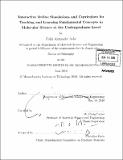| dc.contributor.advisor | W. Craig Carter. | en_US |
| dc.contributor.author | Ashe, Colin Alexander | en_US |
| dc.contributor.other | Massachusetts Institute of Technology. Dept. of Materials Science and Engineering. | en_US |
| dc.date.accessioned | 2010-10-12T18:35:40Z | |
| dc.date.available | 2010-10-12T18:35:40Z | |
| dc.date.copyright | 2010 | en_US |
| dc.date.issued | 2010 | en_US |
| dc.identifier.uri | http://hdl.handle.net/1721.1/59212 | |
| dc.description | Thesis (Ph. D.)--Massachusetts Institute of Technology, Dept. of Materials Science and Engineering, 2010. | en_US |
| dc.description | Includes bibliographical references (p. 213-218). | en_US |
| dc.description.abstract | The number of research disciplines that focus, at least in part, on the atomic or molecular level is rapidly increasing. As a result, the concepts that describe the behavior of atoms and molecules, known collectively as "Molecular Science", are becoming an educational necessity for an expanding fraction of college and university students. Unfortunately, these concepts are challenging for students to learn. Because of the growing importance of these concepts and their difficulty, a project was undertaken with the goal of helping students to understand these concepts using simplified, interactive models. Students in their first year of undergraduate study were targeted. The primary goal of the project was to help students understand the so-called "energy landscape", also known as the "potential energy surface". This concept is central to Molecular Science because it contains information about both equilibrium and kinetic properties of a system. It is also widely used in textbooks and by experts for reasoning qualitatively. Interactive simulations, along with related curriculum, were created in order to help students understand the energy landscape and explore its implications. The simulations visualize simplified models, which were chosen for their analogic connection to chemical systems as well as their similarity to things with which students could intuitively relate. The primary models used were two- and three-dimensional cardboard boxes, as well as a series of platforms covered with balls. The models were simulated and visualized in Java applets. Curriculum sequences consisting of applets, exercises, and explanations were carefully constructed to present concepts in a logical order. The materials were made available online at MatDL.org, the materials pathway of the National Science Digital Library. The curriculum sequences were used as a supplemental exercise by students at Kent State University, Carnegie Mellon University (CMU), and the Massachusetts Institute of Technology (MIT). Two large assessments of student learning were conducted: one at CMU and one at MIT, involving over 400 total students. Assessment results demonstrated that using the project materials improved students' performance on the assessment tests with a greater than 99.9% degree of confidence. Free response comments indicated that students found the exercises helpful and interesting. | en_US |
| dc.description.statementofresponsibility | by Colin Alexander Ashe. | en_US |
| dc.format.extent | 218 p. | en_US |
| dc.language.iso | eng | en_US |
| dc.publisher | Massachusetts Institute of Technology | en_US |
| dc.rights | M.I.T. theses are protected by
copyright. They may be viewed from this source for any purpose, but
reproduction or distribution in any format is prohibited without written
permission. See provided URL for inquiries about permission. | en_US |
| dc.rights.uri | http://dspace.mit.edu/handle/1721.1/7582 | en_US |
| dc.subject | Materials Science and Engineering. | en_US |
| dc.title | Interactive online simulations and curriculum for teaching and learning fundamental concepts in molecular science at the undergraduate level | en_US |
| dc.type | Thesis | en_US |
| dc.description.degree | Ph.D. | en_US |
| dc.contributor.department | Massachusetts Institute of Technology. Department of Materials Science and Engineering | |
| dc.identifier.oclc | 666364130 | en_US |
